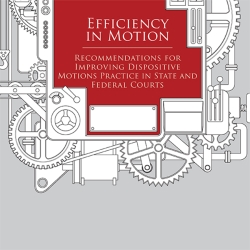Professional Judgment Key for Students, Lawyers—and Improvements to Dispositive Motions Practice

As a law professor, I have the pleasure of watching law students evolve from 1Ls who are shocked—and somewhat dismayed—at the remarkable intricacies of civil procedure, to 2Ls and 3Ls who slowly become adept at using the rules to advance a real or simulated client’s case. The goal, of course, is that these students develop into lawyers who are able to use the rules zealously, and cooperatively, to successfully resolve their client’s cases. We all know that zealous advocacy does not mean fighting over every pleading, discovery request, or motion. Zealous advocacy requires the skillful integration of facts and law to identify the crux of the case and the professional judgment to determine the best way to move toward resolution. I tell my students that the best lawyers are not the ones that leave “no stone unturned” but rather they are the ones who know which stones are critical to the outcome of the dispute and focus their attention on those stones. I believe this type of professional judgment lies at the core of every successful litigator.
This message is reinforced loud and clear in IAALS’ Recommendations for Improving Dispositive Motions Practice in State and Federal Courts, which state:
"[W]hile dispositive motions can make civil litigation more efficient, they can also have the opposite effect. Excessive or improper motions, inefficient processes, and untimely rulings by the court can inject significant cost and delay into the system."
The Recommendations are the culmination of a multiphase project by IAALS, called Efficiency in Motion, to address the challenges of dispositive motions practice. To inform the project, IAALS undertook a docket study of ten United States District Courts to report on the current use of summary judgment. IAALS then convened a group of judges, attorneys, and scholars from around the country to discuss the findings of the docket study, identify problems, and brainstorm practical solutions. The project relied upon important animating principles, such as “the dispositive motions process must be right-sized and tailored to the needs of the case” and “cooperation and communication between counsel is critical to the speedy, effective, and inexpensive resolution of dispositive motions.”
The Recommendations that resulted from this process represent the deep experience of a wide variety of stakeholders. A number of judges at the convening discussed their experience holding pre-motion conferences to discuss proposed dispositive motions. The judges noted that, in the right cases, such pre-motion conferences provided an opportunity to resolve issues more efficiently than if a dispositive motion had been filed and ruled upon.
Experience is an invaluable resource, and IAALS deserves credit for shining a light on innovative ideas such as this. The students of today will become the lawyers of tomorrow, and I hope that they will rely upon resources such as the IAALS Recommendations as they progress through their professional lives—and that their legal educators will stress the importance of these Recommendations during their professional formation. For students and members of the bar alike, this is a call for a more targeted and focused approach to dispositive motions that will better serve clients and the system.



